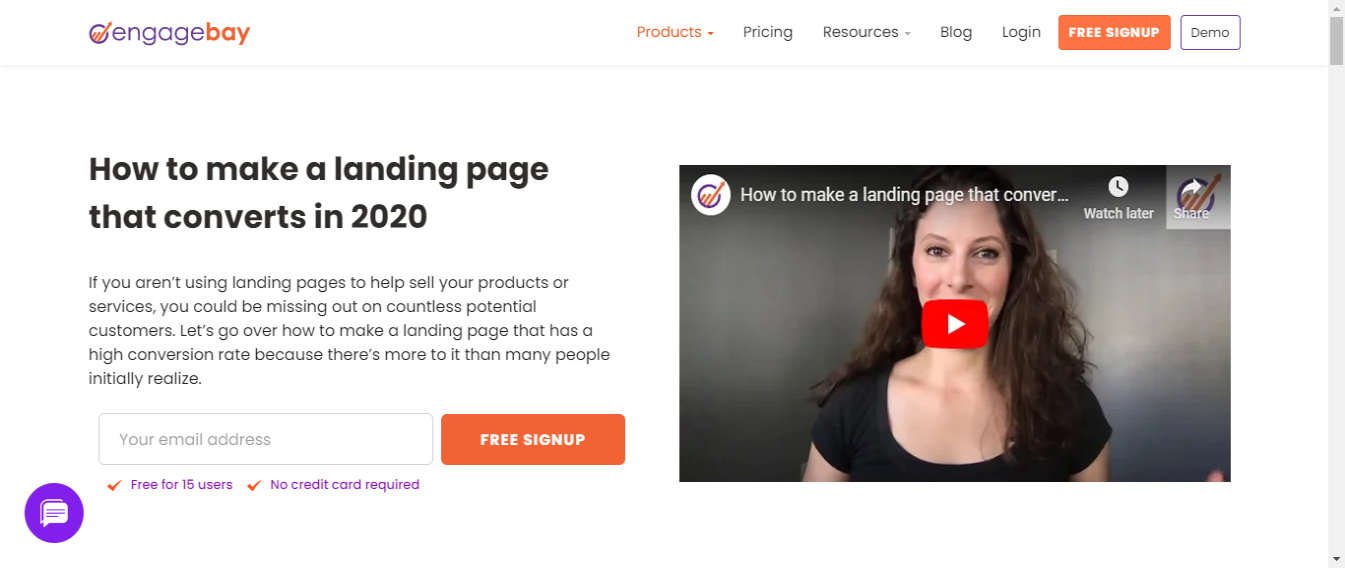
17 Best Landing Page Builder Software for 2021
By Daniel Ndukwu
A landing page builder is an essential part of your marketing stack.
It can help you do everything from collect webinar registrants to selling high-end consulting services.
When you get your landing pages right, your business grows faster and doors open.


On KyLeads alone, we have over a hundred landing pages which serve different segments of our audience, help us build our list, and show the world how awesome we are #Imjustsaying.
The landing page software you select is just as important as what you put on the page. Choose the right one and you have a versatile tool that can help you grow your brand. Choose incorrectly and you have a piece of software that’ll hold you back.
In this post, you’ll get a rundown of 15 powerful landing page builder software solutions that’ll help you grow your leads, customers, and brand awareness.
Note: This article contains some affiliate links which means we get a small commission at no extra cost to you. However these are the tools we recommend when it comes to building the best landing pages and would continue to recommend them without a commission.
What is a landing page builder and why do they matter?
A landing page builder is a software program that makes it possible to build conversion focused landing pages from a template or from scratch without having to write the code yourself. There are predesigned elements such as buttons, forms, image containers, a wide range of fonts and extra fewtures such as analytics and A/B testing.
It differs from a website builder in a number of ways. In most instances a website builder isn't designed for conversion focused pages and lacks many of the features to achieve that effect but makes it easier to create a uniform structure for all pages. For example, a uniform header and footer.
a landing page builder is ideal for a standalone page that doesn't need to match the enitre website exactly. For example a sales page that has a similar design as the rest of a website but doesn't have the same menu or footer.
Why should you get a separate landing page builder?
While you may be able to create a conversion focused landing page with a website builder like WordPress, it'll take you considerbable time and resources. Just hinding the menu on WordPress requires an additional plugin.
There are no built in forms for lead capture, buttons for directing visitors to other pages, or even control of the spacing between blocks. To achieve that kind of effect would require the ability to edit code. It also takes considerably more time. That's not including A/B testing, analytics, and everything else.
Multiply that by twenty conversion focused landing pages and the tests you're running and you can see why it's not a cost effective solution. With a landing page builder, you can pay a few dollars a month and have all the features you need to spin up multiple pages, create tests, and track conversions in just a few hours.
Just tell me what best landing page builders are
This is the TL;DR version so you can get up and running ASAP.
Instapage – I’ve used instapage extensively in the past because it was easy to learn and take advantage of. It has an emphasis on optimizing the post-click experience with personalization, experimentation, and quick iteration.
It’s also well designed for teams who are keen on collaborating before shipping the final version of their pages. Though it’s pricier than many tools on this list, it gets the top spot because you’re almost guaranteed to see an increase in conversions when you take advantage of all the features available.
Unbounce – It’s also a strong contender for the landing page creator throne. It combines its landing page software with a huge library of templates so you’re able to create beautiful pages without any prior experience.
It allows you to perform personalization but it doesn’t go quite as far as Instapage. Unless you're handling tens of thousands of dollars in PPC spend a month, you don't need that level of personalization anyways. It makes up for it with a strong feature set and an easy-to-use testing engine that’ll help you find the best page variation (and a pocket friendly price point).
Leadpages – Leadpages has been evolving into more than a landing page builder over the last few years. Now, it’s a page builder, ads manager, and checkout solution.
The core landing page tool comes with a wide range of features, seamless A/B testing, and tons of integrations so you can plug it into your current marketing stack and start seeing results.
It’s ideal for people who want a powerful solution but don’t have the budget for something like Instapage.
Landing page tools ranking criteria
The software on this list scored high points based on specific factors such as personal experience and reviews from unbiased platforms like Capterra.
Ease of use
How easy is it to get started with the landing page software? Do I need to have one of the employees walk me through it or can I click around and figure out the most important things? Are the buttons and elements in the right place and do they have useful labels? Can I use advanced features easily or does that require a training course on its own?
Support
Do they offer support via multiple channels such as a knowledge base, live chat video tutorials, etc? When I do reach out to support, how responsive are they and how knowledgeable are the support reps I encounter?
Pricing
How much does it cost in absolute terms and is the price reasonable for the features offered? Are there limitations on your ability to create pages due to the plan you choose?
Templates
How many templates does the landing page maker have? Are the templates well designed? Can you customize every aspect of the templates? Are they well organized and do they also have mobile-specific designs?
Integrations
Does the software play nice with your current marketing stack or do you have to start hooking everything up with APIs? Are they constantly adding new integration partners?
The 15 best landing page builder software solutions
- Instapage
- Unbounce
- Leadpages
- Engagebay
- Elementor
- Simvoly
- Landingi
- Wishpond
- Getresponse
- Convertri
- Hubspot
- Pagewiz
- Moosend
- Thrive Architect
- Ucraft
- ConvertKit
- Lander
1. Spectra Page Builder
The Spectra page builder is new to the scene but is already making waves and being used on over 3+ million websites.
It’s a well-designed builder that integrates into the WordPress block editor. There’s nothing new to learn, nothing to slow down page load times and no downsides, especially as Spectra is free.
This Elementor alternative adds 28 blocks to the editor along with block patterns, wireframes and readymade site templates.
Spectra supports block presets, flexbox containers, global color and typography settings and copy and paste for block styles. There’s a lot you can do with this plugin, which is why it’s in the list.
We also like it because it’s built using React and features a just-in-time compiler (JIT). This means Spectra only loads code if you use a Spectra block and the code it uses is optimized for speed. There should be no discernible impact to page load times if you use it.
The page builder has also been designed to be as compatible as possible. It works seamlessly with WordPress, WooCommerce, SureCart and all compliant themes and plugins. It can even work alongside other page builders!
The premium Spectra Pro adds more blocks, support for dynamic content, a loop builder, popup builder, modal builder, animations and VIP support.
Pros:
- 28 new building blocks;
- Integrates into the WordPress block editor;
- Includes block patterns and wireframes;
- Readymade website templates;
- Fast performance;
- Lean, clean code.
Cons:
- No AI integration.
Pricing
Spectra is free and Spectra Pro costs from $49 per year.
2. Instapage
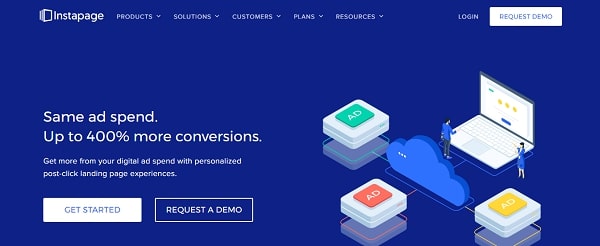
As mentioned in the TL;DR section, Instapage is a powerful landing page builder. It’s come a long way since its humble beginnings as a landing page tool that only charged $5/m. The platform has been positioned as the perfect way to optimize your post-click experience and gets customers an average conversion rate of 22%.
It does this by dividing the tool into multiple sections or use cases. You have the page builder with hundreds of mobile-optimized templates and a feature called the Thor Render Engine™ which helps your pages move lightning fast.
Of course, it supports A/B and multivariate testing, has a drag and drop editor, and lets you track different conversion types through the platform. Like many landing page tools, it also comes with a large number of native integrations to different tools like Mailchimp.
What sets Instapage apart and helps it lock in the number one spot is the deep emphasis on personalizing every step of the visitor’s journey. The AdMap™ feature allows you to connect each ad to a personalized landing page, track the relevance, and gives you a score based on performance.
Pros
- Team collaboration
- Unlimited everything on all plans
- Large number of native integrations
- Powerful personalization engine
- Easy-to-use A/B testing
- Heat maps
- Tons of professional-looking templates
Cons
- Limited icons and images in the free library
- It may be too expensive for most people just gettings started with landing pages.
Pricing
Instapage, for all intents and purposes, only has one pricing plan which costs at $199/m or $149/m when paid yearly. If you need more features then there’s an enterprise plan available with undisclosed pricing.
Rating - 4.5 stars (281 reviews via Capterra)
3. Unbounce
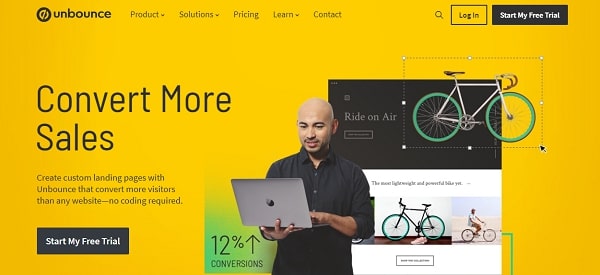
Unbounce is an old staple in the landing page software space. It was one of the first on the market and made a name for itself with its intuitive yet powerful page builder. It comes with over one hundred mobile optimized templates, a drag-and-drop interface, and an A/B testing engine that helps you uncover the best pages in a fraction of the time.
It has a newer feature called smart traffic which uses AI to route your visitors to the page they’re most likely to convert. It can start to optimize with as little as 50 visitors and, on average, there’s a 20% conversion lift over A/B testing. In a lot of cases, that's the difference between a profitable campaign that will scale your business and one that loses money.
You can still take advantage of manual A/B and multivariate testing. Change little things like the headline or completely redesign your pages and run them head to head to see which one brings in more conversions.
When using the platform, data updates in real-time and makes it possible to see the effects of variations or tweaks to a page instantly. When using paid ads, you’re able to dynamically replace text on pages to match the terms the searcher used which increases relevance and conversions.
In addition to landing pages, it also offers popups and sticky bars to help capture contacts.
Pros:
- The page builder can be learned within a few hours
- Deep integrations with other marketing tools
- Optimized with Google Page Speed insights in mind
- Huge library of professional looking templates
- Very fast pages and AMP support
- Everything is customizable
Cons:
- Limits the number of pages you can publish based on your plan
Pricing
Unbounce has three pricing plans which range from $99/m - $499/m with an option to save 20% when you sign up for an annual plan.
Rating – 4.6 (191 reviews on Capterra)
4. Leadpages
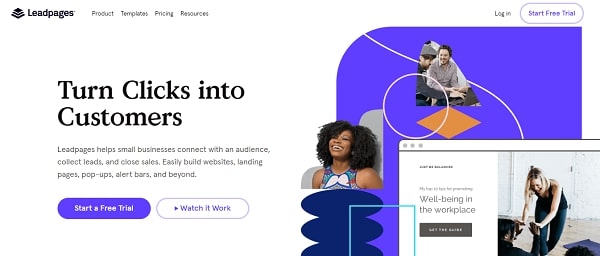
Leadpages is one of the most popular landing page builders on the market and has gone through an evolution over the years. It started as templates where you could only change the text and colors. Today, it has a true drag and drop editor.
It has a huge library of free templates as well as a marketplace to buy templates that catch your eye. You can also find templates based on the conversion rate people have gotten. Within the builder, there’s a feature called LeadMeter which gives you recommendations to further optimize your pages.
In addition to a landing page maker, it has evolved into a complete website builder. This could be a great choice if you’re planning on creating a large number of conversion-focused pages for your website.
Leadpages has a direct integration with Facebook Ads. You can create and publish ads tied to specific landing pages from within Leadpages. It’ll pull information from your page and create the skeleton of the ad which you can then tweak until you’re happy.
Connect with Stripe and create checkout experiences for your customers. It’s still in the early stages and doesn’t allow you to do advanced things like one-click upsells but is still a viable solution if you don’t have complicated checkout needs. Think of it as being ideal for consulting or one-off digital products.
Pros:
- Large number of templates
- Optimized mobile pages with a focus on speed
- Recommendations while building your pages to ensure a higher conversion rate
- Integrations with major email and CRM services
- SMS opt-in feature
- Easy to get started
Cons:
- Creating larger pages like sales pages may slow down the builder
- Customization for minute details (think moving a button a few pixels) can be difficult
Pricing
Leadpages has three pricing tiers that range from $37/m to $321/m when paid month to month. Plans are divided based on the number of websites you’re able to use it on and the features available.
Rating – 4.5 (113 reviews on Capterra)
5. EngageBay
EngageBay is a powerful landing page tool that offers a simple drag-and-drop style landing page builder which means that anyone can build landing pages without technical expertise.
What I like about EngageBay is that every element of your landing page is customizable after you choose the template, which means that you have a lot of flexibility and options. SEO wasn't forgotten as you can set the meta title, description, and target keywords with ease. The platform also lets you set up event actions for when a visitor subscribes.
Of course, there's a dedicated analytics page through which you can track basic information such as the number of visitors, conversion rate, etc. Also, it’s possible to find the number of subscribers if you set up a form on the landing page.
When you choose this landing page builder, you also get access to multiple other features such as email marketing automation, lead capture forms, email templates, and more.
Pros:
- The simple drag-and-drop approach makes it easy to use
- The ability to customize every element removes the need for coding
- Numerous responsive templates to choose from
- Possible to optimize the landing page for SEO
- Real-time insights for not just page metrics but also form related metrics
- Free plan available
Cons:
- Could do with more templates for building the landing pages
Pricing:
The landing page builder comes as a part of the Marketing Bay on EngageBay. There’s a free plan if you have up to 1000 contacts and emails. The paid plans start from $7.79/month/user and go all the way up to $49.99/month/user for up to 30000 contacts and emails.
Rating — 4.6 (64 Capterra reviews)
6. Elementor
WordPress is the most popular CMS on the planet. It’s gained such a level of popularity by enabling users to create the most dynamic, comprehensive websites you can think of. Here’s the problem though:
To create a truly unique WordPress website, you’ll need to know how to code. Or do you? With Elementor, you can create dynamic WordPress websites without having to write a single line of code.
Elementor has a pretty significant user base. Those looking to craft landing pages that are both visually stimulating and optimized for conversions can leverage Elementor’s unique landing page builder.
With beautiful, responsive templates and an intuitive drag & drop live editor, you can pretty much craft any kind of landing page you desire. Given that Elementor is a WordPress website builder, you’ll be able to choose from a variety of high-converting, fully responsive landing page templates. A foundational element of a WordPress site (together with themes), these templates would be difficult to customize if you weren’t using Elementor.
What sets Elementor apart is its form builder. With 20(!) dedicated form fields, you can collect the information you need and customize the design and layout of the form to perfectly match it to your popup.
It doesn’t end there. All the information you collect will automatically be stored in Elementor, where you can then easily manage entries, export your data, and follow the status of submissions. All of this happens within your Elementor account.
Pros:
- Incredibly easy to use
- Deep integrations with other marketing & CRM tools (e.g. Mailchimp, HubSpot & GetResponse)
- Connects with analytics & optimization tools, such as Google Analytics, Hotjar & Optimizely
- Vast library of professional looking templates
- Huge user community to consult with and seek inspiration from
- Truly an all-in-one website creation platform
Cons:
You will need to upgrade to a paid plan to leverage Elementor’s full breadth of widgets and features.
Pricing
Along with its free plan, Elementor offers users 4 subscription plans. The most basic plan costs US$49 per year. You can create one website with that plan.
Other plans go for $199 per year (allows you to create 25 websites), $499 per year (allows you to create 100 websites) and $999 per year (allows you to create 1000 websites).
7. Simvoly
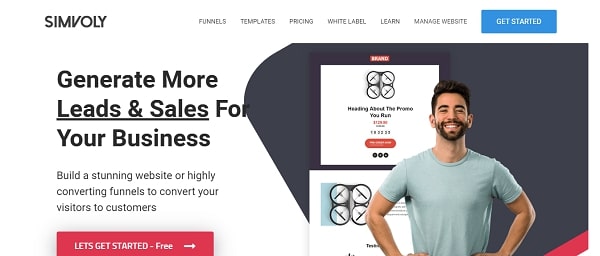
Simvoly may not be as popular as other tools on this list but it comes with a great set of features. It’s geared towards helping you create entire sales funnels. Of course, you can build beautiful landing pages and customize them to your heart's content.
Beyond that, you’re able to integrate directly with payment processors like Stripe and create simple high converting checkout pages. It also makes it easy to turn your pages into one click or upsells or downsells to maximize revenue. Taken together, it’s a great solution to help you build websites that convert.
Pros:
- Funnel builder
- Checkout and one-click upsells
- Simple drag and drop editor
- Free SSL for all hosted pages
- CRM for contacts collected through the platform and customers
Cons:
- Not designed for higher traffic sites because traffic caps out at 400K pageviews
Pricing:
For what it offers, Simvoly is a relatively cheap landing page creator. Plans start at $12/m and go up to $149/m. The traffic maxes out at 400K visitors a month and there doesn’t appear to be an option for more traffic at this point.
Rating – 4.7 (31 Capterra reviews)
8. Wishpond
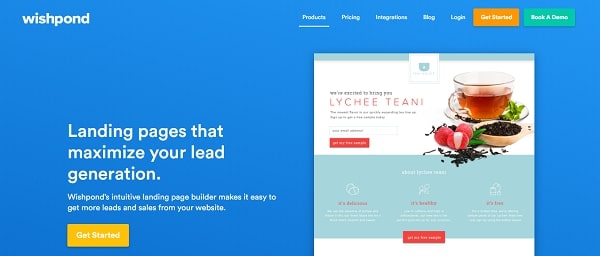
Wishpond is a jack of all trades. I won’t say it’s a master of none because the landing page software is a solid option. It leads with over 100 templates that cater to dozens of different industries and are mobile-ready right out the gate. It follows that up with the ability to create your pages with a drag and drop editor.
Of course, it comes with A/B testing, mobile-only customization, and deep analytics so you can understand what’s working and do more of it. Opt-in forms are also fully customizable so you can collect all the information needed to qualify leads.
Pros:
- Drag-and-drop builder
- Ability to publish directly to platforms such as WordPress
- Unlimited testing variations
- Fully customizable opt-in forms
- Large number of templates
Cons:
- Can be overwhelming to learn how to use the platform at first
Pricing
The amount you pay depends on the features and number of leads you collect every month. It starts at $49/m and can go as high as $2898/m for the maxed-out plan.
Rating - 4.2 (60 reviews on Capterra)
9. GetResponse
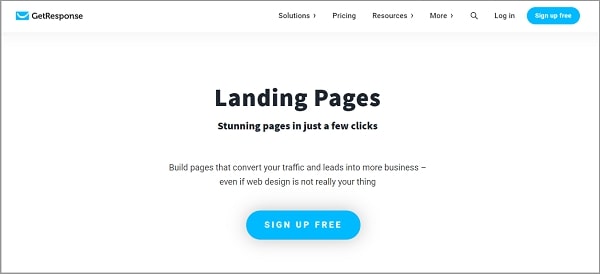
GetResponse has come a long way from the time it was simple email marketing tool with an autoresponder. It’s now a complete funnel solution that includes a landing page builder. The reason it’s so powerful is that it integrates with other tools in the GetResponse product suite such as webinars and Facebook ads management.
The landing page software tool includes a drag-and-drop builder, integrations with Giphy and Shutterstock, a large number of mobile responsive themes, A/B testing engine, and so much more. It also allows you to collect payments and incorporate one-click upsells to maximize revenue.
Pros:
- Entire product suite to support landing pages
- Large number of integrations
- Multiple support options and channels
- Ability to collect payments and one-click upsells
- Deep customization options
- API connections to Shutterstock and Giphy
Cons:
- Large range of options can feel overwhelming
Pricing
GetResponse pricing is tied directly to the number of contacts you have and the features you need. It starts at $15/m and can exceed $1,199/m. It’s also further divided by the features you have access to.
Rating - 4.1 stars (213 reviews on Capterra)
10. Landingi
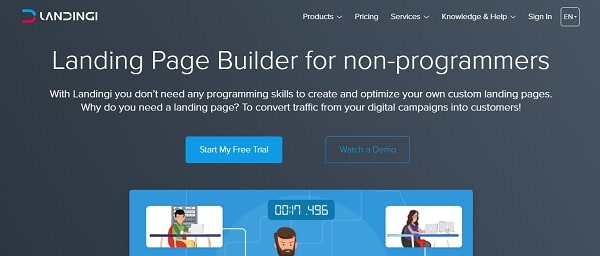
Landingi is an older player in the landing page software space. It does everything you’d need in a solid landing page builder such as provide templates, make it easy to implement A/B tests, and it has a drag-and-drop builder.
It also incorporates popups that help you turn visitors into qualified leads. All the forms have built-in spam protection and validation features to vet contacts before launching marketing campaigns. It’s a solid tool that will help you create your landing pages but it doesn’t do much more than that.
Pros:
- Simple interface that can be learned in a few hours
- Large library of integrations
- Decent template library
- Also has popups
- Can build out entire funnels in the tool
Cons:
- Limited feature set
- Support limited by plan tier
Pricing
Landingi has a lower price point than many tools on this list. It starts at $15/m for one domain and two landing pages and can set you back $78/m for its highest tier. The plans are divided based on the number of pages you can publish, traffic to those pages, and features.
Rating – 4.8 (81 reviews on Capterra)
11. Convertri
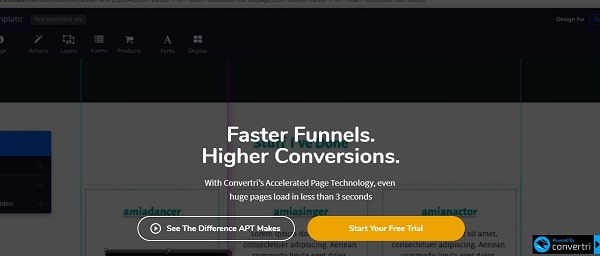
Convertri is a landing page builder solution with a clear emphasis on speed. It has created accelerated page technology. With Google prioritizing faster pages and users abandoning slow ones, it makes sense to go with a landing page tool that focuses on speed.
In addition to page speed, you have access to a large template library, an integrated shopping cart, and a drag-and-drop builder to make landing page creation easy. You can incorporate countdown timers, background videos, and even dynamic text replacement to increase conversions.
Pros:
- Emphasis on lightning-fast pages
- Completely free-form drag and drop editor
- Wide range of elements to customize your landing pages
- Ability to validate form contacts
- Automatically creates beautifully designed mobile pages
Cons:
- Event builder has a steeper learning curve than many other tools
Pricing:
It has reasonable pricing for the features offered. It starts at $53/m paid annually and goes up to $166/m.
Rating – 4.9 (35 Capterra reviews)
12. Hubspot
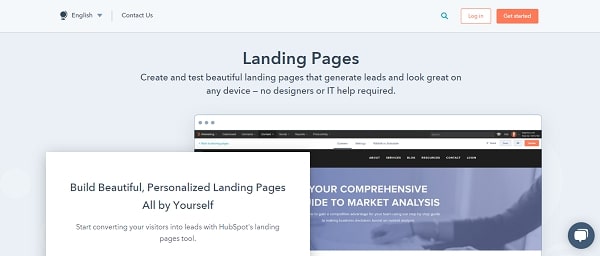
HubSpot is everyone’s favorite marketing solution. It made a name for itself with its inbound marketing philosophy and then built the technology to support it. The landing page tool it has created makes it simple to get professional-looking pages online.
Like GetResponse, the landing page tool leverages the entire HubSpot platform to help you deliver a unique experience to visitors. You’re able to choose from several templates, customize with a drag and drop editor, and optimize with A/B testing and analytics. From sign up to the first page going live, you should spend no more than an hour because of the intuitive interface.
Pros:
- Responsive landing pages and templates
- Ability to create custom form fields to qualify leads
- Can incorporate live chat, bots, and popups
- Personalize content and CTAs
Cons:
- Since there are so many tools and features, it may take a lot of time to understand how all of them work together.
Pricing:
Pricing ranges from $50/m to $3,200/m and can fluctuate based on the number of contacts you have on the platform.
Rating - 4.5 (3,981 reviews on Capterra)
13. Pagewiz
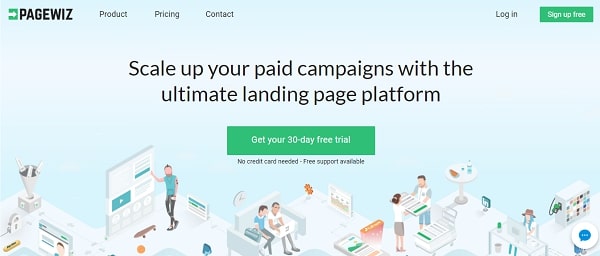
Pagewiz is a landing page builder with an emphasis on conversion optimization as well as modern design. It has over 100 templates designed from the ground up following current marketing best practices. All you have to do is make a few tweaks to match your brand and you’ll have an impressive professional-looking design.
It comes with clear analytics that help you understand what’s working and the ability to run A/B tests to get to the best page variation.
On top of templates and analytics, it also has a free-form drag and drop editor, form editor, and support for custom code.
Pros:
- Large library of templates
- Easy to get started and use
- Integrates with major CRMs and email services
- Tons of custom fonts
- Access API to make custom integrations
Cons:
- The builder can be restrictive if you’re an advanced user
Pricing:
Pricing starts at $29/m for this landing page software and maxes out at $199/m at 100,000 visitors a month before you’ll need an enterprise plan.
Rating – 4.5 (13 Capterra reviews)
14. Moosend
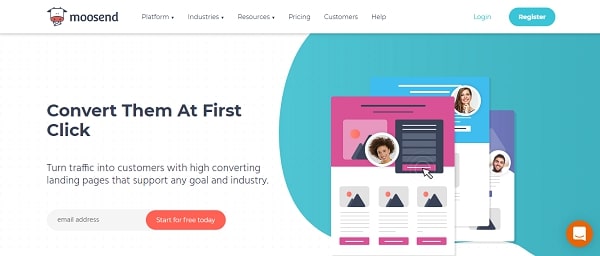
Moosend is relatively new to the landing page software game but they’re developing a solid product. It is part of the email marketing service so it doesn’t have integrations with other CRMs or Email marketing tools which is important to keep in mind.
With that being said, it has the major features you need to create beautiful pages. It comes with templates, a drag-and-drop editor, and support for custom HTML to make whatever it is you need.
Pros:
- Part of an entire suite of tools
- Simple drag-and-drop editor
- Deep reporting and analytics across your funnel
- Countdown timers to instill urgency
- Mobile responsive landing pages
Cons:
- Limited feature set when compared to specialized landing page builders
Pricing:
Moosend offers all of its features on a single plan which is free if you have less than 1,000 contacts. The first paid offering is $10/m and goes to more than $3,650 if you have over 1 million contacts.
Rating – 4.9 (96 Capterra reviews)
15. Thrive architect
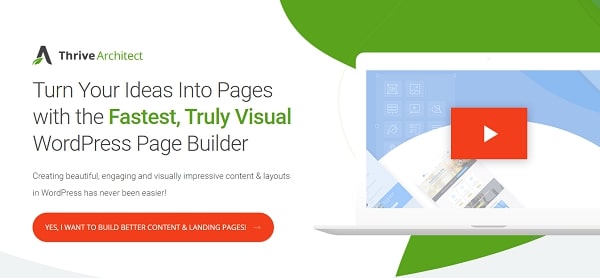
Thrive Architect is one of the most powerful landing page builders for WordPress. Unlike many of its WordPress competitors, it has a truly visual drag and drop builder. You’re able to choose from a large range of templates and even what’s known as smart templates.
One of the interesting features of Thrive Architect is the ability to create global blocks known as symbols. If you make changes on one page, it reflects across every instance where that block is used. There are plenty of customization options and features like countdown timers, content block templates, and more.
Pros:
- Integrates deeply with WordPress
- Large number of integrations with email marketing and CRM services
- Wide range of templates for different industries
- Different effects such as hover, zoom, etc. for elements
- Full control of customization
- Mobile-specific editing
Cons:
- Can’t do A/B test unless you get another plugin
- Can’t track forms performance unless you get another plugin
Pricing:
$67 - $97 one-off depending on the number of websites you want to use it on. It also has an option for a monthly membership at $19/m which gives you access to all of the Thrive Themes plugins.
Rating – N/A
16. Ucraft
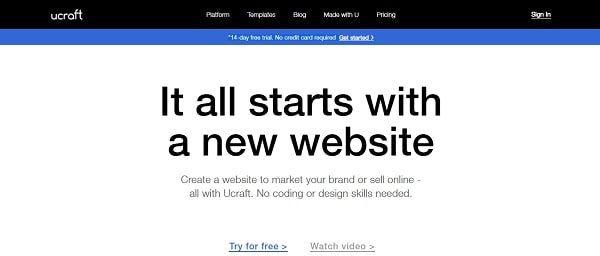
Ucraft is a combination website and landing page builder that comes with over 80 templates to get you up and running quickly. It has an integrated checkout and storefront solution guaranteed to help you generate revenue online.
It comes with SEO tools, multilanguage support, team management, and a drag and drop editor that works with blocks. The forms are optimized to capture more leads and you can customize almost every element dropped onto a page.
Pros:
- Fully responsive
- Free to start
- Can be used as your entire website
- Large template library
- 24/7 support
Cons:
- Missing some of the true landing page functionality such as A/B testing
Pricing:
Free - $69/m depending on the features you need.
Rating - 4.7 (103 Capterra reviews)
17. ConvertKit
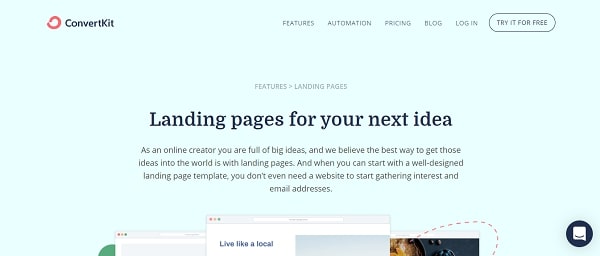
ConvertKit is first and foremost an email marketing service that has started to expand its feature set to meet the needs of its customers. The landing page builder doesn’t have a lot of features right now but the team is actively developing it.
ConvertKit does the basics well but doesn’t have advanced features you’d expect in a dedicated landing page builder. The benefit comes from it combining landing pages and email marketing which can save time, money, and energy. It integrates with a few essential tools like Google Analytics and Segment but not other CRMs and email services.
Pros:
- Template library to get started quickly
- Spin up pages with a simple interface
- Mobile optimized pages
- Custom data collection with forms
Cons:
- Limited feature set
Pricing:
The cost is determined by how many subscribers you have. It starts at $29/m and can go up to $3,999/m before you get into custom enterprise pricing.
Rating – 4.8 (82 reviews on Capterra)
18. Lander
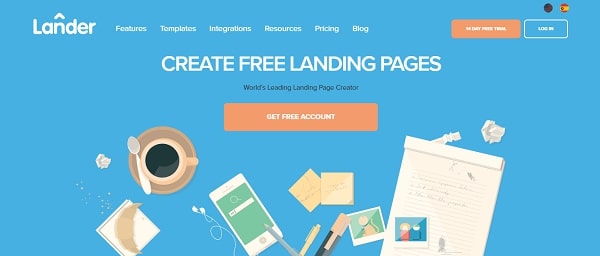
Lander has been around for several years and has built a free-to-try tool that’s excellent for beginners. It has a large number of templates and allows you to edit the mobile and desktop versions separately.
It integrates with many email marketing services like Aweber and Mailchimp but some are noticeably absent like GetResponse and ActiveCamapaign which can be a major drawback. Most of the templates are professional-looking and it provides an A/B testing feature that allows you to optimize your pages over time.
Pros:
- Countdown timers
- Autofill form support
- Human readable analytics
- PayPal integration to collect payments
- Over 100 templates
Cons:
- Need to design mobile and desktop versions separately
- Limited advanced features
- Limited traffic allocation on their plans
Pricing:
There are two pricing plans which are $49/m and $99/m respectively. I believe the plans are too expensive and too limiting for what’s being offered. The way pricing is set up, you get a steep discount if you opt to pay yearly.
Rating – 4 (2 Capterra reviews).
So what’s the best landing page builder?
Few decisions are as impactful as the landing page tool you choose for your business. They can make or break your conversions.
Which one is the best tool for you?
That depends on several factors. Do you want an all in one solution? If so, GetResponse may be a good option for you.
Are you looking for a tool that can build amazing landing pages and give you deep analytics and customization options? Unbounce and Instapage are good choices.
Do you need something powerful but pocket-friendly? Leadpages is the best option for that.
In the end, this guide is just that – a guide. The final choice rests with you.
Copyright 2018 - 2020, KyLeads. All rights reserved.

